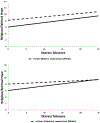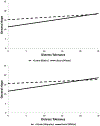Keeping hope alive: Racial-ethnic disparities in distress tolerance are mitigated by religious/spiritual hope among Black Americans
- PMID: 33730637
- PMCID: PMC8919343
- DOI: 10.1016/j.jpsychores.2021.110403
Keeping hope alive: Racial-ethnic disparities in distress tolerance are mitigated by religious/spiritual hope among Black Americans
Abstract
Racial and ethnic minorities, including Blacks/African-Americans and Hispanics/Latinos,indicate lower tolerance to psychological distress (DT) and secular hope yet endorse more religious and spiritual hope than their non-Hispanic White (NHW) counterparts. Whether racial-ethnic minorities derive greater benefit from non-secular hope on the tolerance of psychological distress remains unclear. Self-reported endorsement of religious/spiritual (R/S) hope, secular hope, DT, and a number of other psychosocial, R/S and sociodemographic variables were analyzed from a nationwide survey of persons aged over 18 years (N = 2875) identifying as Black (14.2%), Hispanic (15.4%), or NHW (67.3%) using multiple regression. Overall, higher levels of both R/S and secular hope predicted greater DT. In turn, greater DT was associated with lower psychosomatic distress. Compared to NHW, the ethnic-minority groups reported lower overall levels of DT. An interaction for race-ethnicity further revealed that compared to distress intolerant NHW, Blacks/African-Americans at lower levels of DT report higher R/S and secular hope. Hispanics/Latinos were also higher on R/S and secular hope, but endorsed lower hope at higher levels of DT than the reference group. Although hope is considered a more passive form of coping, it is more frequently endorsed in marginalized ethnic-minority groups. However, compared to NHW, differences do exist in the extent to which R/S hope mitigates DT in Blacks/African-Americans compared to Hispanics/Latinos.
Keywords: Distress intolerance; Positive psychology; Psychosomatic distress; Racial-ethnic disparity; Religion and spirituality.
Copyright © 2021. Published by Elsevier Inc.
Figures


Similar articles
-
The relation between diabetes self-efficacy and psychological distress among older adults: do racial and ethnic differences exist?J Aging Health. 2015 Mar;27(2):320-33. doi: 10.1177/0898264314549662. Epub 2014 Sep 17. J Aging Health. 2015. PMID: 25231883 Free PMC article.
-
Racial and Ethnic Differences in Dietary Intake, Physical Activity, and Body Mass Index (BMI) Among Cancer Survivors: 2005 and 2010 National Health Interview Surveys (NHIS).J Racial Ethn Health Disparities. 2017 Dec;4(6):1138-1146. doi: 10.1007/s40615-016-0319-8. Epub 2017 Jan 11. J Racial Ethn Health Disparities. 2017. PMID: 28078657
-
Risk of disordered eating at the intersection of gender and racial/ethnic identity among U.S. high school students.Eat Behav. 2019 Aug;34:101299. doi: 10.1016/j.eatbeh.2019.05.002. Epub 2019 May 9. Eat Behav. 2019. PMID: 31153023
-
End-of-Life Care for People With Cancer From Ethnic Minority Groups: A Systematic Review.Am J Hosp Palliat Care. 2016 Apr;33(3):291-305. doi: 10.1177/1049909114565658. Epub 2014 Dec 29. Am J Hosp Palliat Care. 2016. PMID: 25550406 Review.
-
Racial/Ethnic Differences in Childhood Blood Lead Levels Among Children <72 Months of Age in the United States: a Systematic Review of the Literature.J Racial Ethn Health Disparities. 2016 Mar;3(1):145-53. doi: 10.1007/s40615-015-0124-9. Epub 2015 May 15. J Racial Ethn Health Disparities. 2016. PMID: 26896114 Review.
Cited by
-
Religion and Suicide in Black Emerging Adults: Examining Pathways Through Hope and Meaning in Life.J Youth Adolesc. 2024 May;53(5):1119-1133. doi: 10.1007/s10964-023-01930-3. Epub 2024 Jan 20. J Youth Adolesc. 2024. PMID: 38244102
-
Attitudes of Black American Christian church leaders toward Opioid Use Disorder, overdoses, and harm reduction: a qualitative study.Front Psychiatry. 2024 Apr 3;15:1359826. doi: 10.3389/fpsyt.2024.1359826. eCollection 2024. Front Psychiatry. 2024. PMID: 38633031 Free PMC article.
-
Number of Chronic Medical Conditions and Quality of Life of Ethnic Minority Older Adults.Geriatrics (Basel). 2022 Sep 29;7(5):106. doi: 10.3390/geriatrics7050106. Geriatrics (Basel). 2022. PMID: 36286209 Free PMC article.
-
Advance Care Planning for Children With Rare Diseases: A Pilot RCT.Pediatrics. 2024 Jun 1;153(6):e2023064557. doi: 10.1542/peds.2023-064557. Pediatrics. 2024. PMID: 38699801 Clinical Trial.
-
Anxiety-related constructs and smoking outcome expectancies among Latinx smokers.Exp Clin Psychopharmacol. 2023 Oct;31(5):942-952. doi: 10.1037/pha0000625. Epub 2022 Dec 8. Exp Clin Psychopharmacol. 2023. PMID: 36480393 Free PMC article.
References
-
- Aiken LS, West SG, Reno RR, Multiple Regression: Testing and Interpreting Interactions: Sage, 1991.
-
- Allan NP, Macatee RJ, Norr AM, Schmidt NB, Direct and interactive effects of distress tolerance and anxiety sensitivity on generalized anxiety and depression, Cogn. Ther. Res 38 (5) (2014) 530–540.
-
- Anderson JR, The Role of Hope in Appraisal, Goal-Setting, Expectancy about Future Success, and Coping, University of Kansas, Psychology, 1988.
-
- Anestis MD, Selby EA, Fink EL, Joiner TE, The multifaceted role of distress tolerance in dysregulated eating behaviors, Int. J. Eat. Disord 40 (8) (2007) 718–726. - PubMed
-
- Ang DC, Ibrahim SA, Burant CJ, Siminoff LA, Kwoh CK, Ethnic differences in the perception of prayer and consideration of joint arthroplasty, Med. Care 40 (6) (2002) 471–476. - PubMed
Publication types
MeSH terms
Grants and funding
LinkOut - more resources
Full Text Sources
Other Literature Sources
Medical

